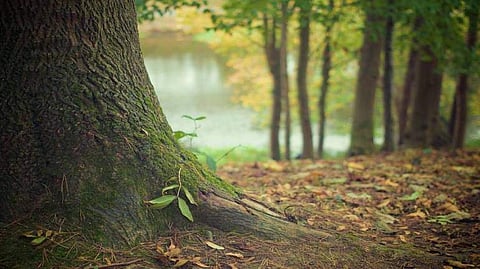

With the World Earth Day, there was a hearty celebration for the children of the Hennagara Government High School in Hennagara village in Karnataka. They celebrated the first birthday of 5500 trees that were planted over a half acre area in the school last year which had grown into 10 ft tall from saplings in a year's time and now looks like a forest.
Eighty various species of plants like neem, jamun, silk, cotton, banyan, amla, peepal, guava, bamboo, honge and many more were used to plant the saplings. The saplings were planted to create a Japanese Miyawaki forest. "Miyawaki plantation involves plantation of native species of plants close to each other where saplings are placed randomly on the forest bed ensuring that no two similar varieties are adjacent to each other. Soil testing is done to provide organic nutrition to the soil. We add biomass in the soil and the soil is loosened up to a depth of one meter. The biomass like cocopeat, rice husk, cow dung or anything locally available is mixed with the soil to create the forest bed. This creates a microclimate which promotes healthy competition amongst the saplings leading to faster growth," said Durgesh Agrahare, Head of Partnership and Project at Saytrees, a voluntary group.
With the continuous maintenance of the forest by watering the plants and removal of weeds and adding in extra nutrients to the plants by this the plants were able to grow healthier without any damage.
This apart, the beautiful forest produced on the campus of the government school has attracted many children in the school. It has become an add on study class for them. The teachers and the Say trees volunteers are teaching the students about different species of plants and also about maintenance of these plants. The students also take the initiative to water the plants by themselves. "The children were very happy to see the forest. It has grown in no time. That is the speciality of the Miyawaki technique. A 100-year-old forest will grow in just 10 years," said Agrahare.
This apart on the World Earth Day, a clean-up drive also was carried out with 25 volunteers who cleared up the trash in the forests.
So far Saytrees has planted over 50,000 saplings using Miyawaki method, their aim is to plant another 5,00,000 saplings using the same technique in 2019. On World Earth Day, a group of 15 children from Marthahalli organised a run picking up waste in their locality. The children collected bottles, chocolate wrapper, tobacco packets, bottle caps, chips packets and many more. The children wish to carry more such runs in their summer holidays and they are bringing in awareness of the 4 R's — Reduce, Reuse, Recycle and Rejoice.
